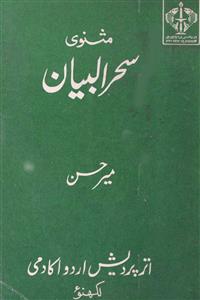Urdu Masnavi is one of the most captivating poetic forms in Urdu literature. This genre presents continuous and interconnected storytelling in poetic form, covering historical events, romantic tales, moral teachings, or mystical themes. Typically written in a specific poetic meter, Urdu Masnavi has played a crucial role in preserving literary and cultural history. Influenced by Persian poetry, flourished in Urdu literature, with masterpieces like Masnavi Sehar-ul-Bayan by Mir Hasan and Gulzar-e-Naseem by Pandit Daya Shankar Naseem as prime examples.
Mir Hasan: The Maestro of Urdu Masnavi
Among the most celebrated Urdu Masnavi poets, Mir Hasan holds a special place. Unlike his contemporaries who focused on Ghazal poetry, Mir Hasan dedicated himself to perfecting the art of Urdu Masnavi. Born in 1727 in Delhi, he hailed from a distinguished literary family. Under the guidance of his father, Mir Zahak, and the esteemed poet Khwaja Mir Dard, he honed his poetic skills. The political upheaval in Delhi forced him to migrate to Awadh, where he faced courtly challenges in Lucknow. Despite these difficulties, his poetry gained immense popularity among the masses.
The Masterpiece: Sehar-ul-Bayan
Mir Hasan’s Sehar-ul-Bayan is considered a landmark in Urdu Masnavi, immortalizing his name in literary history. This Urdu Masnavi is among his twelve works, also known as the tale of Badr Muneer and Prince Be-Nazir. The poem beautifully captures the essence of its era, depicting societal customs, traditions, and lifestyles with remarkable accuracy. It incorporates elements of folklore, such as fairies, demons, and mystical beings, all wrapped in a lucid and elegant language. Despite using archaic words, the Urdu Masnavi remains fluid and engaging, showcasing Mir Hasan’s mastery of narration and poetic expression.
The Storyline of Sehar-ul-Bayan
At the heart of this Urdu Masnavi is an emotional tale of love, fate, and destiny. It begins with a kind-hearted king who longs for a child. After years of despair, astrologers predict the birth of a magnificent prince, Be-Nazir. However, his fate is intertwined with grave dangers. Despite the king’s precautions, an unfortunate event leads the prince to the mystical land of fairies, where he is imprisoned by the enchanting fairy, Mah Rukh. Eventually, with the help of Princess Badr Muneer and her confidante Najm-un-Nisa, the prince is rescued, and the story reaches a heartwarming conclusion. Mir Hasan’s poetic fluency, use of idioms, and intense emotions make Sehar-ul-Bayan a timeless Urdu Masnavi treasure.

Rashid Ahmed Siddiqui’s Tribute to Urdu Masnavi
Renowned literary critic Rashid Ahmed Siddiqui delivered a thought-provoking radio lecture titled “Husn Aafreen, Marhaba Marhaba” on May 3, 1953, later published in Aligarh Magazine. He eloquently highlighted the vastness and diversity of Urdu Masnavi, particularly emphasizing its significance. He noted that while Persian poetry granted Masnavi an esteemed position, Urdu poets embraced and enriched the genre.
Siddiqui extensively praised Mir Hasan’s contributions, acknowledging that although the poet originated from Delhi, his poetry found immense appreciation in Lucknow. He also compared the literary environments of Delhi and Lucknow, stating that Mir Hasan’s refined language, deeply rooted in Delhi’s linguistic traditions, evolved into a more polished and sophisticated style in Lucknow.
The Legacy of Urdu Masnavi in Literature
Urdu Masnavi remains a cornerstone of Urdu literature, intertwining history, culture, and art into an elegant poetic form. Rashid Ahmed Siddiqui concluded that Sehar-ul-Bayan is a poetic masterpiece and a historical document that vividly portrays the social and cultural landscape of its time. Even today, Urdu Masnavi continues to captivate scholars, poets, and enthusiasts, ensuring that its rich tradition endures for generations to come.
Conclusion: The grandeur of Urdu Masnavi, especially Sehar-ul-Bayan, showcases Mir Hasan’s artistic brilliance. Whether through literary discussions or academic studies, this poetic genre remains significant in Urdu literature. If you are an admirer of classical poetry, exploring Urdu Masnavi is a journey worth taking!
Are you interested in more Urdu literary masterpieces? Stay connected for more insights into the world of Urdu poetry and storytelling!
If you’d like to listen to this book in audio format, click the CONTACT button below to get in touch with the AwazeUrdu team to order the audiobook.
You can also watch the same video on these social media platforms.
اردو مثنوی شاعری کی ایک اہم صنف ہے جس میں مسلسل اور مربوط انداز میں کوئی داستان، تاریخی واقعہ، عشقیہ قصہ، اخلاقی تعلیم، یا تصوف کے نکات بیان کیے جاتے ہیں۔ یہ عام طور پر طویل ہوتی ہے اور مخصوص بحر میں لکھی جاتی ہے۔ اردو میں مثنوی کی روایت فارسی شاعری سے متاثر ہو کر پروان چڑھی۔ مثنوی سحر البیان (میر حسن) اور گلزار نسیم (پنڈت دیا شنکر نسیم) اردو مثنوی کی بہترین مثالیں سمجھی جاتی ہیں۔ اس صنف نے نہ صرف ادب بلکہ تہذیب و ثقافت کی تاریخ کو محفوظ رکھنے میں بھی اہم کردار ادا کیا ہے۔ اردومثنوی کےخالقوں میں ایک اہم نام میرحسن دہلوی کاہے۔
میر حسن اردو کے نامور شاعر تھے جنہوں نے غزل کے بجائے مثنوی کو اپنایا اور اسے کمال تک پہنچایا۔ ان کا تعلق ایک علمی و ادبی خانوادے سے تھا، جس نے اردو شاعری کو لازوال ورثہ دیا۔ 1727ء میں دہلی میں پیدا ہونے والے میر حسن نے ابتدائی تعلیم اپنے والد میر ضاحک سے حاصل کی اور خواجہ میر درد کی صحبت میں شاعری سیکھ کر نکھاری۔ دہلی کی تباہ حالی کے بعد وہ اودھ منتقل ہوئے، مگر لکھنؤ میں سیاسی و درباری سازشوں کی وجہ سے مشکلات کا سامنا کرنا پڑا۔ ان کی مشہور مثنوی سحرالبیان، جو اردو شاعری کا شاہکار سمجھی جاتی ہے، دربار میں پذیرائی حاصل نہ کر سکی، مگر عوام میں بے حد مقبول ہوئی۔ میر حسن کی زبان کی صفائی، محاکات نگاری اور محاورات کا حسن اردو ادب میں ان کا منفرد مقام قائم کرتا ہے۔ ان کے پوتے میر انیس نے مرثیہ نگاری میں وہی کمال دکھایا جو میر حسن نے مثنوی میں حاصل کیا تھا۔
مثنوی “سحرالبیان” میرحسن کالافانی کارنامہ ہے،یہ میرحسن کی لکھی گئی 12 مثنویوں میں سے ایک ہے جسے قصہ بدرمنیر و شہزادہ بے نظیر وغیرہ کے نام سے بھی جانا جاتا ہے، اس مثنوی کے ذریعہ میر حسن نے اپنےعہد کی تصویر کشی اور معاشرت کی بھرپور عکاسی کی ہے،اس زمانے کا رہن سہن، رسم و رواج ہر چیز اصل کے مطابق دکھائی گئی ہے۔ اسی طرح منظرکشی بھی ہر لحاظ سے مکمل ہے،مثنوی میں جن، دیو اور پریاں بھی نظر آتی ہیں،متروک الفاظ ہونے کے با وجود مثنوی کی زبان سادہ،سلیس اور رواں ہے، میر حسن کو اس مثنوی پر ناز تھا۔ مثنوی کے شروع میں میر حسن کی سوانح اور قصہ کا خلاصہ بھی موجود ہے۔
مثنوی سحرالبیان ایک رومانوی داستان ہے جس میں ایک نیک دل بادشاہ کو اولاد کی نعمت حاصل نہ ہونے پر مایوسی کا سامنا کرنا پڑتا ہے۔ نجومیوں کی پیش گوئی کے مطابق ایک حسین شہزادہ بے نظیر پیدا ہوتا ہے، مگر اس کی زندگی کو خطرات لاحق ہوتے ہیں۔ حفاظتی تدابیر کے باوجود ایک غلطی کی وجہ سے شہزادہ پریوں کے دیس پہنچ جاتا ہے، جہاں ماہ رخ پری اسے قید کر لیتی ہے۔ بعد میں بدر منیر شہزادی اور اس کی رازدار نجم النساء کی کوششوں سے بے نظیر کی رہائی ممکن ہوتی ہے، اور کہانی ایک خوشگوار انجام کو پہنچتی ہے۔ میر حسن کی شاعری کی روانی، محاورات کا برمحل استعمال اور جذبات کی شدت اس مثنوی کو اردو ادب میں ہمیشہ کے لیے امر کر دیتے ہیں۔
“حسن آفریں،مرحبامرحبا” کےنام سےاس تاریخی مثنوی کےبارےمیں رشیداحمدصدیقی مرحوم کی یہ تقریر3مئی 1953ءکوآل انڈیاریڈیو،دہلی سےنشرہوئی اور بعدازاں علی گڑھ میگزین طنزوظرافت نمبر(1953)میں شائع ہوئی۔ جس میں اردو شاعری کے تنوّع اور وسعت پر روشنی ڈالتے ہوئے کہتے ہیں کہ اردو میں جتنی صنفیں اور شاعرانہ سانچے موجود ہیں، شاید ہی کسی اور ہندوستانی زبان میں ملتے ہوں۔ وہ طنزیہ انداز میں اس بات کا اظہار کرتے ہیں کہ چونکہ انہیں دیگر زبانوں کا علم نہیں، اس لیے وہ بلا جھجک یہ دعویٰ کر سکتے ہیں۔
وہ اردو شاعری میں مثنوی کی اہمیت بیان کرتے ہیں اور اس صنف کے ساتھ اردو شاعروں کی لازوال محبت کا ذکر کرتے ہیں۔ ان کے مطابق فارسی شاعری میں مثنوی کو خاص مقام حاصل تھا، اور اردو شاعری نے بھی اسی کی پیروی کی۔ دکن میں اردو شاعری کے ابتدائی دور میں بھی مثنوی کو خاص اہمیت دی گئی۔
رشید احمد صدیقی میر حسن کی شاعری اور ان کی مشہور مثنوی سحر البیان پر تفصیل سے گفتگو کرتے ہیں۔ وہ لکھتے ہیں کہ میر حسن دہلی کے تھے لیکن لکھنو آکر بس گئے، اور وہاں ان کی شاعری کو زبردست پذیرائی ملی۔ ان کی سحر البیان کو اردو کی بہترین مثنویوں میں شمار کیا جاتا ہے، اور بعض نقادوں کے نزدیک یہ مثنوی اپنی مثال آپ ہے۔
مضمون میں لکھنؤ اور دہلی کے ادبی ماحول کا بھی موازنہ کیا گیا ہے، اور یہ بیان کیا گیا ہے کہ میر حسن کی زبان، باوجود دہلوی پس منظر کے، زیادہ نکھری ہوئی اور شستہ ہے۔ رشید احمد صدیقی اس بات پر زور دیتے ہیں کہ شاعری نہ صرف ایک ادبی اظہار ہے بلکہ یہ تاریخ، تہذیب، اور ثقافت کی بھی عکاس ہوتی ہے۔ سحر البیان میں اس عہد کے رسم و رواج، رہن سہن، عشق و محبت کے انداز، بازاروں، باغات، اور خواتین کی گفتگو تک کی جیتی جاگتی تصویر کشی کی گئی ہے۔
آخر میں وہ یہ نتیجہ اخذ کرتے ہیں کہ سحر البیان نہ صرف شاعری کا شاہکار ہے بلکہ یہ اپنے عہد کی مستند تاریخی دستاویز بھی ہے، اور اردو شاعری میں مثنوی کی اہمیت ہمیشہ برقرار رہے گی

